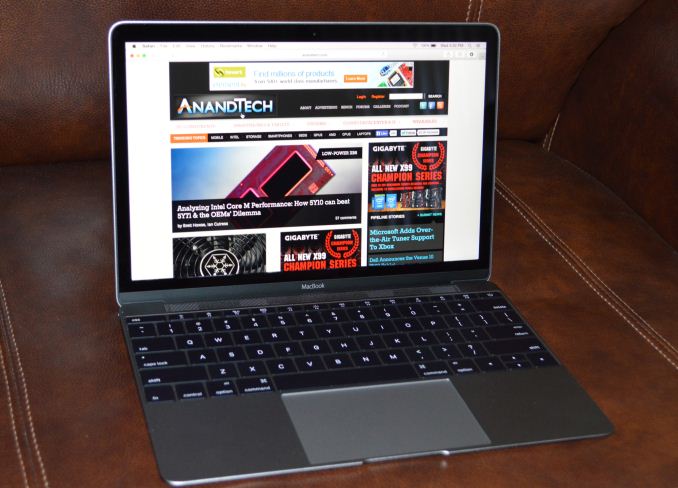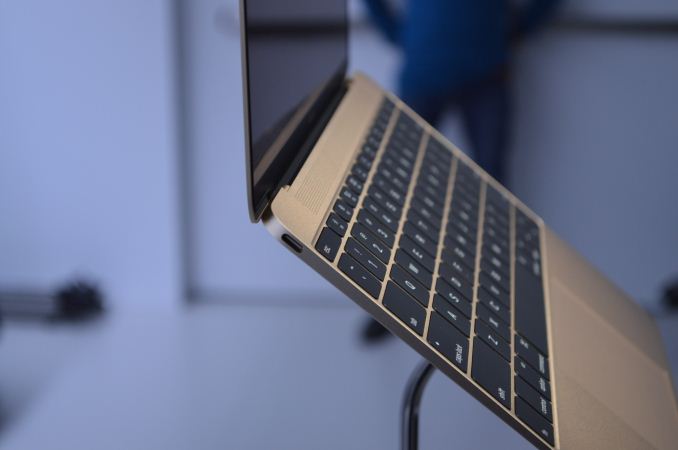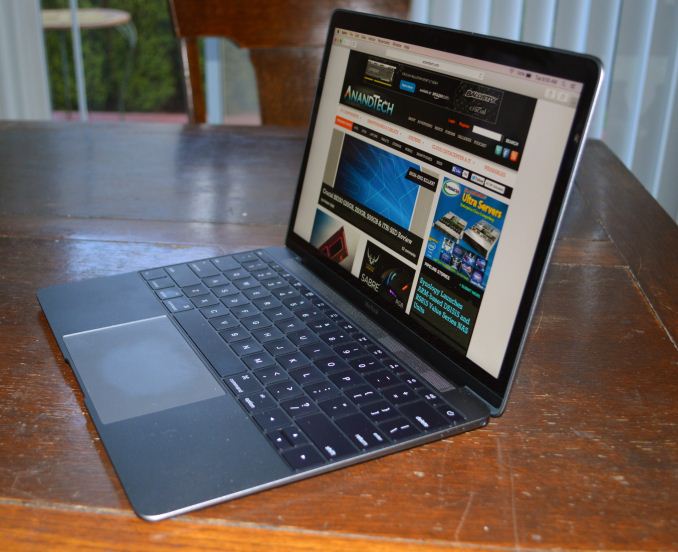The 2015 MacBook Review
by Ryan Smith on April 14, 2015 10:15 AM ESTFinal Words
Bringing this MacBook review to a close, I’m going to start where I left off in our introduction, which was the concept of the laptop/tablet crossover. The idea of laptops and tablets crossing over is no longer merely an idea, but now it is reality. Apple for their part may not be doing any kind of wild 2-in-1 transforming design, or even pushing the concept of a touchscreen OS X device, but they have clearly tapped their immense experience with tablets in putting together the new MacBook.
From a design perspective then the end product is clearly a Mac laptop, but it’s a Mac laptop that’s more tablet-like than any before it. From the small size, to the low weight, the choice of a Core M processor, the passive, fanless cooling system, and of course the choice of metallic colors, the MacBook pushes against the line that separates Apple’s laptops from their tablets.
There are of course numerous benefits and drawbacks from this, with some of them being obvious and others a bit more subtle. The biggest benefit of course is the size; the MacBook is a 0.92kg, 1.31cm thick professional grade Mac laptop, with many of great features that come with such a device. If the Retina MacBook Pro were miniaturized, then it would end up looking and behaving a lot like the MacBook that Apple is delivering today.
The biggest drawback in turn is what you give up to pack a full Mac into such a small laptop. Make no mistake, Core M is no slouch, and in bursting workloads can perform very well. But when faced with sustained workloads, a 4.5W processor can only go so far, and it’s not going to be able – nor is it meant to – keep up with the more powerful processors found in the MacBook Air and Retina MacBook Pro. The end result then is performance that’s anywhere between on-par with last year’s MacBook Air to the MacBook Air of a few years ago, depending on the specific task being run.
Meanwhile in the middle are a multitude of new technologies being first introduced in this generation. The new keyboard and its butterfly mechanism are certainly different, and the reduced key travel takes some getting used to, but once accustomed to it I like the stability of the keys. Similarly, the new Force Touch Trackpad is mechanically very different, and I’m still not sold on whether Apple is going to be able to find too many useful situations for the force touch capabilities. But on the other hand I’m definitely impressed with how natural the trackpad feels despite lacking a true switch mechanism and recreating that feel with an electromagnet instead.
Also deserving of attention is the MacBook’s 12” Retina IPS display. Particularly since the move to Retina Apple has been doing a great job on producing high quality pro displays, and the MacBook’s doesn’t fail to impress. The MacBook’s display’s out of the box performance is among the best we’ve ever seen, rivaling (and at times exceeding) the Retina MacBook Pro, which is to say that the end product is a very accurate, very sharp display. Mac users have been clamoring for a Mac ultra-portable with a Retina display for some time now, and although I don’t think the MacBook was quite what everyone had in mind, the MacBook’s display certainly is.
And then there’s Apple’s introduction of the USB Type-C port, which on such a small laptop like the MacBook takes on a whole new importance. Apple has always been on the cutting edge of I/O and their rapid adoption of USB Type-C is no exception. Relying on it for both I/O and charging is in turn a logical move given the interface’s capabilities, but I would also have to argue that Apple has taken it too far with just a single Type-C port. The Type-C port was the right call – teething issues and all – but Apple has unnecessarily hindered the MacBook by only giving it the single port. Even with its small, ultra-portable design there are still times where it’s desirable to charge the MacBook and use it with an external peripheral at the same time.
What we’re left with is a solid, though by no means perfect new entry into the MacBook family. I hesitate to call the MacBook a niche product since niche implies highly specialized when in fact the MacBook isn’t quite that specialized – it’s just small – but it’s clearly one product in Apple’s larger lineup. What the MacBook isn’t is a replacement for the Retina MacBook Pro or MacBook Air – at least not today – as it’s a laptop for users who already have other laptops or desktops; it is a second computer, not a first one. And admittedly this is the same designation that was applied to the MacBook Air on its launch several years ago, but as the Air’s performance has improved over the years and it was shifted to Apple’s entry-level laptop, it has certainly become the sole computer for an increasing portion of its user base.
Speaking solely for myself here, I’ve come away rather impressed with the MacBook. As an 11” Ultrabook user I already have a fondness for the weight and size of the form factor, and as a journalist frequently carrying around a laptop to trade shows and meetings I particularly appreciate the reduction in weight. The regression in performance is unfortunate, but the combination of weight, battery life, the Retina display, and the keyboard in my mind more than make up for the performance the MacBook can’t offer. After all, I have a workstation for when I need performance; what the MacBook fulfills is delivering acceptable performance when I’m away from that workstation and need portability over performance.
Briefly, I also want to touch on price. The MacBook’s $1299 starting price tag is very much an Apple price tag – which is to say expensive – however it’s also one that goes hand-in-hand with markedly improved base specifications for an Apple laptop. The 11” MacBook Air starts at just $899, but as Apple’s entry-level laptop I will also argue until I’m blue in the face that it’s underequipped for 2015; 4GB of RAM and a 128GB SSD aren’t enough. Which is a point I make because after upgrading the Air to a more acceptable 8GB of RAM and a 256GB SSD the price tag is up to $1199, at which point it’s only $100 off of the MacBook. At least compared to the rest of Apple’s lineup I find that the base MacBook isn’t so much expensive as the base MacBook Air is just a bit too cheaply built.
Anyhow, on a broader note, while I doubt Apple was looking quite this far into the future when they created the initial MacBook Air, I get the distinct impression that this is the kind of device they have been building towards. Apple has always been held back by technology to some degree – be it processor size, storage size, or display power requirements – and it’s only now in 2015 that the pieces have come together to allow them to make a laptop this small. I don’t believe this is a stopping point for Apple simply because one way or another they’re going to keep iterating, but compared to the MacBook Air there isn’t the same need nor ability to make a MacBook even smaller.
Which brings me to my final point, which is the future direction of the Apple’s Mac laptop families. The fact that the MacBook is the MacBook, and not the MacBook Nano or some other named MacBook is something I believe is telling. Although there’s clearly a risk in reading too much into Apple’s future plans based on a name alone, I have to seriously wonder where the MacBook and the MacBook Air go from here. Apple still needs an entry-level Mac laptop, but do they need the MacBook Air in particular? Just as the newer MacBook Air rendered the previous generation MacBook redundant in due time, I suspect Apple may intentionally following the same course with the new MacBook. But as to whether that comes to pass, only time will tell.













354 Comments
View All Comments
darkich - Wednesday, April 15, 2015 - link
Oh Anandtech, it is blatantly obvious that you do everything you can to twist reality in favor of your sponsor (Intel).So MacBook has a twice better GPU than iPad Air 2?
Why didn't you used a *graphics* category to explain that fact?
Why didn't you ran Manhattan or T Rex and showed the respective scores?
iLovefloss - Wednesday, April 15, 2015 - link
They linked to a more comprehensive Core M review in the article. If you actually read the damn thing rather than trying to accuse people of being sellouts, then you maybe you'd caught that.Shit, the only thing more annoying than a social media (anti-)SJ conversation is tech websites review comments. Everybody is a sellout.
narcaz - Wednesday, April 15, 2015 - link
I am sorry, but i think this one of the of the more mediocre reviews from Anandtech:"Compared to the 128GB SSD and 4GB of RAM in the base MacBook Airs, this is the first ultra-portable Mac in a while where I can say even the base model feels properly equipped. At the very least users shouldn’t be struggling with RAM or SSD capacity for some time. Meanwhile given the fact that the equivalent upgrade of an 11” MacBook air would be $300 – bringing the total price to $1199 – this means that while the MacBook is still more expensive than a MacBook Air, the difference isn’t nearly as wide as it would first seem."
Copy paste from Apple's marketing? The difference is as wide as it would first seem when you look at the trade-off. Compared to the MBA you get better portability and a retina screen. But you loose connectivity, battery life, hd camera, magsafe, cpu/gpu performance. And according to your defined target audience (second device buyers) buying these upgrades doesn't make much sense. It is ok that the 12'' MB is expensive, but don't try to argue around this fact.
"As far as desktop performance goes, we haven’t found any major problems for the MacBook’s Intel HD Graphics 5300 GPU. Even with Core M’s power limits it doesn’t show any issues holding 60fps at the default virtual resolution of 1280 x 800, though I would not suggest going any higher unless it’s necessary."
I had the impression that higher resolutions don't work very well on the 12'' MB models in the Apple store. It felt like the first 13'' rMBP: more screen space, but a bit laggy. The performance of the HD 4000 wasn't good enough and took another hit with Yosemite (especially when connected to a second display). I am not willing to invest in a MB, which isn't future proof for at least 2-3 years. The same is true for the potential lack of 4K/60hz. I hoped for more depth in this area.
The review could have been more critical about the 1 USB C Port. If it breaks you can't even charge your machine anymore and out of warranty services are extremely expensive. But i think the comments discussed this point to death. Thanks for the extra remarks about the sustained performance in the comments and please put this in the review and maybe do more tests.
wave84 - Wednesday, April 15, 2015 - link
I don't really think the Macbook is expensive. This is actually useable as a main computer for a lot of users (journalists, web designers, web programmers, etc). It will do just fine, as long as you have 8GB RAM and 256 for storage, which you get.You lose some stuff indeed, but for 100 bucks you get retina screen, extreme portability, and most important of all, it's fanless and completely silent. This is a huge quality of life improvement which no review will take into account.
Also, i do not believe the port to be an issue. Either you are docked, so you have plenty of ports (and you only unplug one cable), either you are mobile, when one port is enough for 99% of use cases.
I am very close to buying it. Still waiting for some upgraded CPU numbers.
narcaz - Wednesday, April 15, 2015 - link
I am looking for a second device besides my 15'' rMBP. The iPad doesn't cut it anymore. But 1279$ + 79$ (needed for occasional presentation) is expensive compared to the 11'' MBA 899$+29$. Impossible to sugarcoat it. It looks like Apple's upselling strategy got you on the hook. You can rationalize this purchase as much as you want, but i don't want to pay for upgrades, which i don't need. If you value portability and retina screen fine, enjoy it, but this doesn't make it a very good deal.Even in the Apple ecosystem the single port is problematic. Airplay Screen Mirroring suffers from lags, iCloud Photo Library is cumbersome and there is no backup solution while being on the road. Cables aren't dead. I think the next version will have second port.
telsin - Wednesday, April 15, 2015 - link
I'm curious to see if a newer hardware revision of the Apple TV that they're likely to announce at WWDC resolves some of the airplay lag. That thing is still using an A5 processor, whereas the latest iphones are up to A8 (huge difference in CPU/GPU performance). I too found airplay rather obnoxious when I tried it. In OSX, you can have it treat an airplay target as a second monitor, but it really kind of sucks unless you're just putting something there to read as a static document.bogda - Wednesday, April 15, 2015 - link
Now, make MacBook Air with the same quality screen, smaller bezel (like on this MacBook) and keyboard that stretches from edge to edge (like on this MacBook) and I might actually switch from PC to Mac.Mushin - Wednesday, April 15, 2015 - link
As for the SSD which is only connected through PCIe 2.0 that is a limitation of Core M see:http://ark.intel.com/products/84666/Intel-Core-M-5...
cknobman - Wednesday, April 15, 2015 - link
All I can say is ehh.Sure its built nice and a super small form factor
BUT
Price is high, performance is just OK, and battery life is frankly underwhelming. Sure the battery life is not terrible but given the hype over the Core M I was expecting better battery life.
Still no touch screen and it is still confined to the limitations of a laptop.
The benefit of small underpowered devices like this should lie in their ability to serve multiple purposes easily and change form factors.
If I still have to use it like a laptop (IE: open it up, type on a keyboard) and pay such a high price then I may as well go get a laptop with more power and better battery life.
For this price I'd still rather have something like a Surface Pro 3. With its ability to serve multiple purposes I can use it like a tablet or a laptop, get better battery life, and get a touch screen. All while paying less.
nerd1 - Wednesday, April 15, 2015 - link
Sp3 is lighter, thinner, more powerful, has more ports, has more input methods and even cheaper.